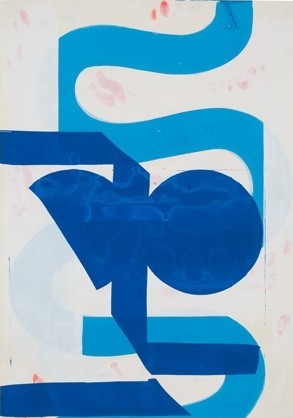Alexander Wagner
13 Apr - 26 May 2012
ALEXANDER WAGNER
13 April – 26 May, 2012
Alexander Wagner’s drawings abound with contradictions. They are modest yet deeply ambitious, abstract yet communicative. Besides the portrait format and their paper supports they seem to speak different languages whilst understanding one another perfectly. Wagner develops his drawings subsequently, his process based work, where one leads to the next - carefully advance neat geometric forms, whilst others are composed of loose gestures and accidents, full of uncontrollable energy.
In the new drawings on view at RaebervonStenglin, Wagner has employed acrylic, spray paint, pencil, felt tip pens, collage and screen printing. The different speeds of his mediums are important to him, as is the varying degrees of control they each impose. Abstraction is thus a means to explore the particular physicalities of materials. Yet in his works dripped pigment can depict bodies of water, triangular forms might shorthand mountains, patterns the façades of buildings, and representation is never far away. A balance is maintained between abstraction, materiality and representation. In some of the drawings a figurative element is depicted, a screen-printed form appearing at first as a part of a larger abstract gesture before it is read figuratively. Such surprises are a characteristic of Wagner’s works and once discerned, the motifs reappear a number of times in the drawings.
Wagner’s influences are vastly various. His works at times recall artists such as Paul Klee, Blinky Palermo or the layered, postmodern canvases of Sigmar Polke, but equally they draw upon styles of music, architecture and typography. Like the drawings and paintings of Agnes Martin, they reference a nature that exists in the mind, sharing with her works their hand drawn geometries; yet Wagner’s mindset is not interested in ideas of perfection, but rather in experience as filtered by culture. None of his influences are explicit or suggested in titles however, and Wagner is content to let the viewer make their own associations as the different materials and techniques interact.
Alexander Wagner was born in 1978 in Berlin, Gemany. His solo exhibitions include ‘Alexander Wagner’, RaebervonStenglin (2010); ‘INSERT, zum zeichnerischen’, Jet, Berlin (2009); ‘mustern’, SOX, Berlin (2008); and ‘Alex Wagner’, NBKstudio (Neuer Berlin Kunstverein), Berlin (2007). Recent group shows include ‘Natural Flavour’, Ricou Gallery, Brussels; ‘Broken Umbrellas’, Laurel Gitlen, New York (all 2011). He lives and works in Berlin.
13 April – 26 May, 2012
Alexander Wagner’s drawings abound with contradictions. They are modest yet deeply ambitious, abstract yet communicative. Besides the portrait format and their paper supports they seem to speak different languages whilst understanding one another perfectly. Wagner develops his drawings subsequently, his process based work, where one leads to the next - carefully advance neat geometric forms, whilst others are composed of loose gestures and accidents, full of uncontrollable energy.
In the new drawings on view at RaebervonStenglin, Wagner has employed acrylic, spray paint, pencil, felt tip pens, collage and screen printing. The different speeds of his mediums are important to him, as is the varying degrees of control they each impose. Abstraction is thus a means to explore the particular physicalities of materials. Yet in his works dripped pigment can depict bodies of water, triangular forms might shorthand mountains, patterns the façades of buildings, and representation is never far away. A balance is maintained between abstraction, materiality and representation. In some of the drawings a figurative element is depicted, a screen-printed form appearing at first as a part of a larger abstract gesture before it is read figuratively. Such surprises are a characteristic of Wagner’s works and once discerned, the motifs reappear a number of times in the drawings.
Wagner’s influences are vastly various. His works at times recall artists such as Paul Klee, Blinky Palermo or the layered, postmodern canvases of Sigmar Polke, but equally they draw upon styles of music, architecture and typography. Like the drawings and paintings of Agnes Martin, they reference a nature that exists in the mind, sharing with her works their hand drawn geometries; yet Wagner’s mindset is not interested in ideas of perfection, but rather in experience as filtered by culture. None of his influences are explicit or suggested in titles however, and Wagner is content to let the viewer make their own associations as the different materials and techniques interact.
Alexander Wagner was born in 1978 in Berlin, Gemany. His solo exhibitions include ‘Alexander Wagner’, RaebervonStenglin (2010); ‘INSERT, zum zeichnerischen’, Jet, Berlin (2009); ‘mustern’, SOX, Berlin (2008); and ‘Alex Wagner’, NBKstudio (Neuer Berlin Kunstverein), Berlin (2007). Recent group shows include ‘Natural Flavour’, Ricou Gallery, Brussels; ‘Broken Umbrellas’, Laurel Gitlen, New York (all 2011). He lives and works in Berlin.

